Accounting Analysis: Share Buybacks and Asset Impairment - Gali Ltd
VerifiedAdded on 2023/04/03
|5
|1557
|264
Report
AI Summary
This report provides a detailed overview of accounting for share buybacks, including the cost method and constructive retirement method, along with the accounting treatment for related transaction costs. It further explains the Australian Accounting Standard AASB 136 on Impairment of Assets, outlining its objectives, scope, and key definitions such as carrying amount, cash-generating unit, and recoverable amount. The report includes a practical analysis of Gali Ltd, demonstrating the calculation of impairment loss and the corresponding journal entries for goodwill, land, copyright, and machinery. The analysis adheres to AASB 136 guidelines, ensuring assets are not carried at amounts exceeding their recoverable value.
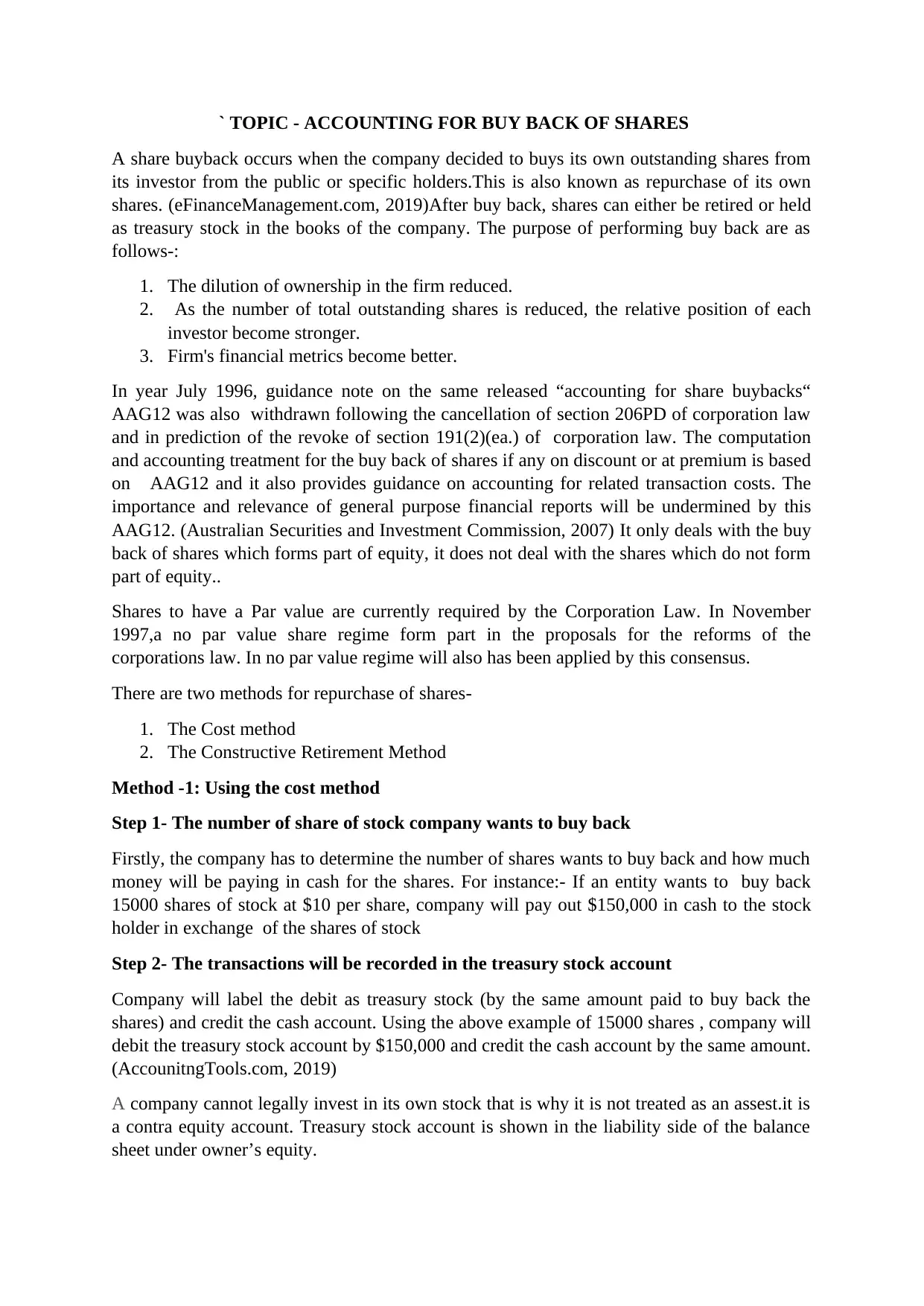
` TOPIC - ACCOUNTING FOR BUY BACK OF SHARES
A share buyback occurs when the company decided to buys its own outstanding shares from
its investor from the public or specific holders.This is also known as repurchase of its own
shares. (eFinanceManagement.com, 2019)After buy back, shares can either be retired or held
as treasury stock in the books of the company. The purpose of performing buy back are as
follows-:
1. The dilution of ownership in the firm reduced.
2. As the number of total outstanding shares is reduced, the relative position of each
investor become stronger.
3. Firm's financial metrics become better.
In year July 1996, guidance note on the same released “accounting for share buybacks“
AAG12 was also withdrawn following the cancellation of section 206PD of corporation law
and in prediction of the revoke of section 191(2)(ea.) of corporation law. The computation
and accounting treatment for the buy back of shares if any on discount or at premium is based
on AAG12 and it also provides guidance on accounting for related transaction costs. The
importance and relevance of general purpose financial reports will be undermined by this
AAG12. (Australian Securities and Investment Commission, 2007) It only deals with the buy
back of shares which forms part of equity, it does not deal with the shares which do not form
part of equity..
Shares to have a Par value are currently required by the Corporation Law. In November
1997,a no par value share regime form part in the proposals for the reforms of the
corporations law. In no par value regime will also has been applied by this consensus.
There are two methods for repurchase of shares-
1. The Cost method
2. The Constructive Retirement Method
Method -1: Using the cost method
Step 1- The number of share of stock company wants to buy back
Firstly, the company has to determine the number of shares wants to buy back and how much
money will be paying in cash for the shares. For instance:- If an entity wants to buy back
15000 shares of stock at $10 per share, company will pay out $150,000 in cash to the stock
holder in exchange of the shares of stock
Step 2- The transactions will be recorded in the treasury stock account
Company will label the debit as treasury stock (by the same amount paid to buy back the
shares) and credit the cash account. Using the above example of 15000 shares , company will
debit the treasury stock account by $150,000 and credit the cash account by the same amount.
(AccounitngTools.com, 2019)
A company cannot legally invest in its own stock that is why it is not treated as an assest.it is
a contra equity account. Treasury stock account is shown in the liability side of the balance
sheet under owner’s equity.
A share buyback occurs when the company decided to buys its own outstanding shares from
its investor from the public or specific holders.This is also known as repurchase of its own
shares. (eFinanceManagement.com, 2019)After buy back, shares can either be retired or held
as treasury stock in the books of the company. The purpose of performing buy back are as
follows-:
1. The dilution of ownership in the firm reduced.
2. As the number of total outstanding shares is reduced, the relative position of each
investor become stronger.
3. Firm's financial metrics become better.
In year July 1996, guidance note on the same released “accounting for share buybacks“
AAG12 was also withdrawn following the cancellation of section 206PD of corporation law
and in prediction of the revoke of section 191(2)(ea.) of corporation law. The computation
and accounting treatment for the buy back of shares if any on discount or at premium is based
on AAG12 and it also provides guidance on accounting for related transaction costs. The
importance and relevance of general purpose financial reports will be undermined by this
AAG12. (Australian Securities and Investment Commission, 2007) It only deals with the buy
back of shares which forms part of equity, it does not deal with the shares which do not form
part of equity..
Shares to have a Par value are currently required by the Corporation Law. In November
1997,a no par value share regime form part in the proposals for the reforms of the
corporations law. In no par value regime will also has been applied by this consensus.
There are two methods for repurchase of shares-
1. The Cost method
2. The Constructive Retirement Method
Method -1: Using the cost method
Step 1- The number of share of stock company wants to buy back
Firstly, the company has to determine the number of shares wants to buy back and how much
money will be paying in cash for the shares. For instance:- If an entity wants to buy back
15000 shares of stock at $10 per share, company will pay out $150,000 in cash to the stock
holder in exchange of the shares of stock
Step 2- The transactions will be recorded in the treasury stock account
Company will label the debit as treasury stock (by the same amount paid to buy back the
shares) and credit the cash account. Using the above example of 15000 shares , company will
debit the treasury stock account by $150,000 and credit the cash account by the same amount.
(AccounitngTools.com, 2019)
A company cannot legally invest in its own stock that is why it is not treated as an assest.it is
a contra equity account. Treasury stock account is shown in the liability side of the balance
sheet under owner’s equity.
Paraphrase This Document
Need a fresh take? Get an instant paraphrase of this document with our AI Paraphraser
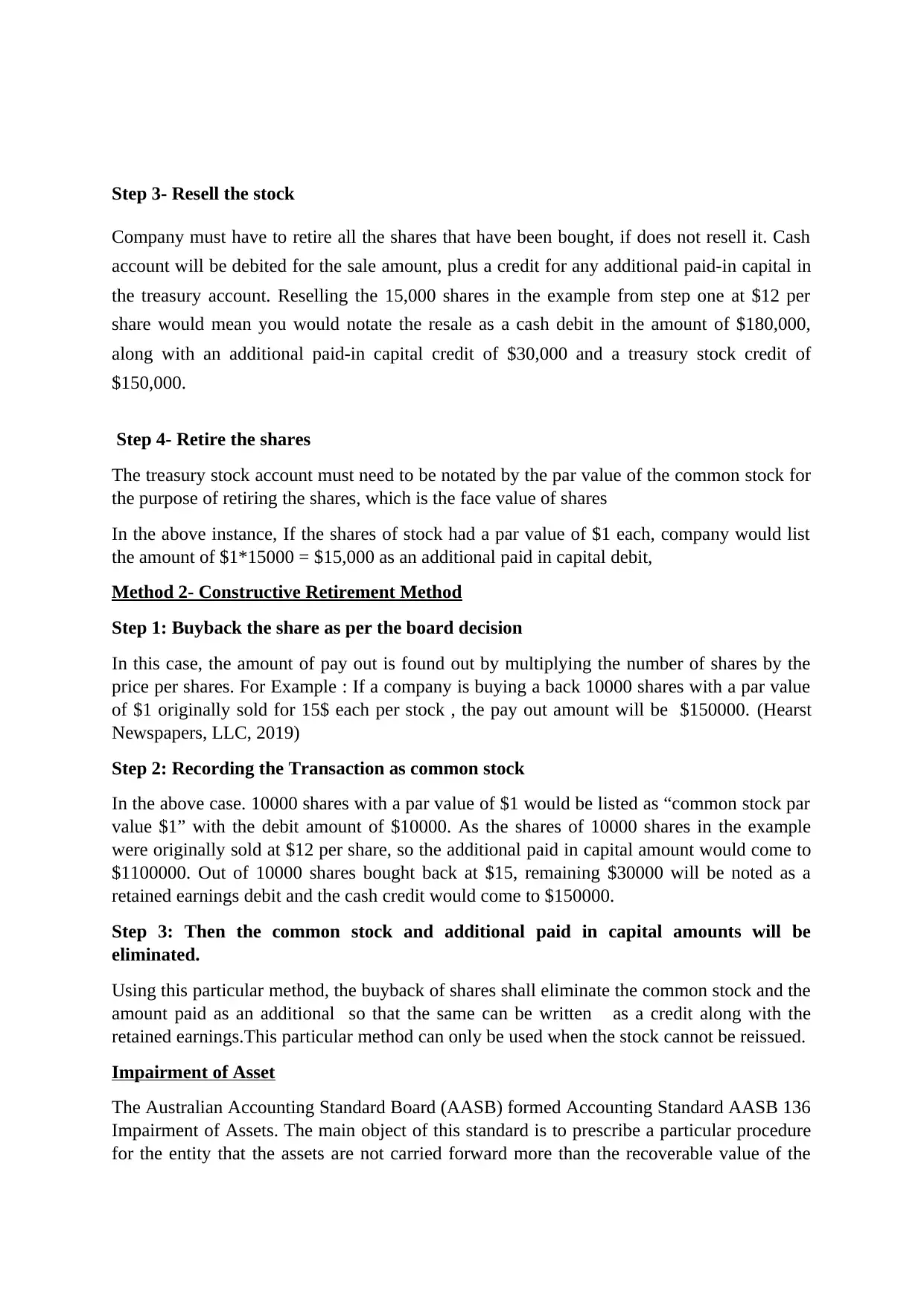
Step 3- Resell the stock
Company must have to retire all the shares that have been bought, if does not resell it. Cash
account will be debited for the sale amount, plus a credit for any additional paid-in capital in
the treasury account. Reselling the 15,000 shares in the example from step one at $12 per
share would mean you would notate the resale as a cash debit in the amount of $180,000,
along with an additional paid-in capital credit of $30,000 and a treasury stock credit of
$150,000.
Step 4- Retire the shares
The treasury stock account must need to be notated by the par value of the common stock for
the purpose of retiring the shares, which is the face value of shares
In the above instance, If the shares of stock had a par value of $1 each, company would list
the amount of $1*15000 = $15,000 as an additional paid in capital debit,
Method 2- Constructive Retirement Method
Step 1: Buyback the share as per the board decision
In this case, the amount of pay out is found out by multiplying the number of shares by the
price per shares. For Example : If a company is buying a back 10000 shares with a par value
of $1 originally sold for 15$ each per stock , the pay out amount will be $150000. (Hearst
Newspapers, LLC, 2019)
Step 2: Recording the Transaction as common stock
In the above case. 10000 shares with a par value of $1 would be listed as “common stock par
value $1” with the debit amount of $10000. As the shares of 10000 shares in the example
were originally sold at $12 per share, so the additional paid in capital amount would come to
$1100000. Out of 10000 shares bought back at $15, remaining $30000 will be noted as a
retained earnings debit and the cash credit would come to $150000.
Step 3: Then the common stock and additional paid in capital amounts will be
eliminated.
Using this particular method, the buyback of shares shall eliminate the common stock and the
amount paid as an additional so that the same can be written as a credit along with the
retained earnings.This particular method can only be used when the stock cannot be reissued.
Impairment of Asset
The Australian Accounting Standard Board (AASB) formed Accounting Standard AASB 136
Impairment of Assets. The main object of this standard is to prescribe a particular procedure
for the entity that the assets are not carried forward more than the recoverable value of the
Company must have to retire all the shares that have been bought, if does not resell it. Cash
account will be debited for the sale amount, plus a credit for any additional paid-in capital in
the treasury account. Reselling the 15,000 shares in the example from step one at $12 per
share would mean you would notate the resale as a cash debit in the amount of $180,000,
along with an additional paid-in capital credit of $30,000 and a treasury stock credit of
$150,000.
Step 4- Retire the shares
The treasury stock account must need to be notated by the par value of the common stock for
the purpose of retiring the shares, which is the face value of shares
In the above instance, If the shares of stock had a par value of $1 each, company would list
the amount of $1*15000 = $15,000 as an additional paid in capital debit,
Method 2- Constructive Retirement Method
Step 1: Buyback the share as per the board decision
In this case, the amount of pay out is found out by multiplying the number of shares by the
price per shares. For Example : If a company is buying a back 10000 shares with a par value
of $1 originally sold for 15$ each per stock , the pay out amount will be $150000. (Hearst
Newspapers, LLC, 2019)
Step 2: Recording the Transaction as common stock
In the above case. 10000 shares with a par value of $1 would be listed as “common stock par
value $1” with the debit amount of $10000. As the shares of 10000 shares in the example
were originally sold at $12 per share, so the additional paid in capital amount would come to
$1100000. Out of 10000 shares bought back at $15, remaining $30000 will be noted as a
retained earnings debit and the cash credit would come to $150000.
Step 3: Then the common stock and additional paid in capital amounts will be
eliminated.
Using this particular method, the buyback of shares shall eliminate the common stock and the
amount paid as an additional so that the same can be written as a credit along with the
retained earnings.This particular method can only be used when the stock cannot be reissued.
Impairment of Asset
The Australian Accounting Standard Board (AASB) formed Accounting Standard AASB 136
Impairment of Assets. The main object of this standard is to prescribe a particular procedure
for the entity that the assets are not carried forward more than the recoverable value of the
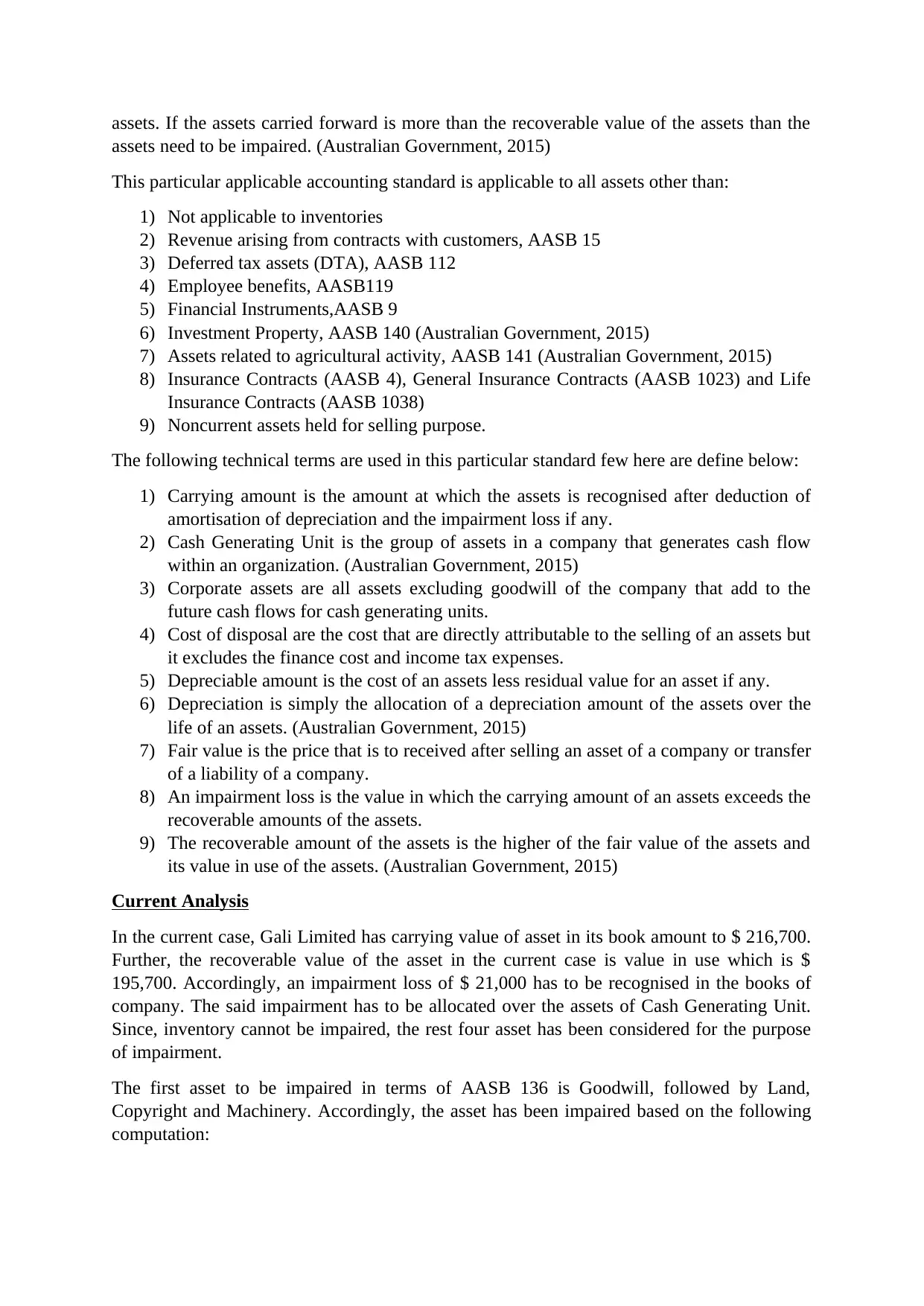
assets. If the assets carried forward is more than the recoverable value of the assets than the
assets need to be impaired. (Australian Government, 2015)
This particular applicable accounting standard is applicable to all assets other than:
1) Not applicable to inventories
2) Revenue arising from contracts with customers, AASB 15
3) Deferred tax assets (DTA), AASB 112
4) Employee benefits, AASB119
5) Financial Instruments,AASB 9
6) Investment Property, AASB 140 (Australian Government, 2015)
7) Assets related to agricultural activity, AASB 141 (Australian Government, 2015)
8) Insurance Contracts (AASB 4), General Insurance Contracts (AASB 1023) and Life
Insurance Contracts (AASB 1038)
9) Noncurrent assets held for selling purpose.
The following technical terms are used in this particular standard few here are define below:
1) Carrying amount is the amount at which the assets is recognised after deduction of
amortisation of depreciation and the impairment loss if any.
2) Cash Generating Unit is the group of assets in a company that generates cash flow
within an organization. (Australian Government, 2015)
3) Corporate assets are all assets excluding goodwill of the company that add to the
future cash flows for cash generating units.
4) Cost of disposal are the cost that are directly attributable to the selling of an assets but
it excludes the finance cost and income tax expenses.
5) Depreciable amount is the cost of an assets less residual value for an asset if any.
6) Depreciation is simply the allocation of a depreciation amount of the assets over the
life of an assets. (Australian Government, 2015)
7) Fair value is the price that is to received after selling an asset of a company or transfer
of a liability of a company.
8) An impairment loss is the value in which the carrying amount of an assets exceeds the
recoverable amounts of the assets.
9) The recoverable amount of the assets is the higher of the fair value of the assets and
its value in use of the assets. (Australian Government, 2015)
Current Analysis
In the current case, Gali Limited has carrying value of asset in its book amount to $ 216,700.
Further, the recoverable value of the asset in the current case is value in use which is $
195,700. Accordingly, an impairment loss of $ 21,000 has to be recognised in the books of
company. The said impairment has to be allocated over the assets of Cash Generating Unit.
Since, inventory cannot be impaired, the rest four asset has been considered for the purpose
of impairment.
The first asset to be impaired in terms of AASB 136 is Goodwill, followed by Land,
Copyright and Machinery. Accordingly, the asset has been impaired based on the following
computation:
assets need to be impaired. (Australian Government, 2015)
This particular applicable accounting standard is applicable to all assets other than:
1) Not applicable to inventories
2) Revenue arising from contracts with customers, AASB 15
3) Deferred tax assets (DTA), AASB 112
4) Employee benefits, AASB119
5) Financial Instruments,AASB 9
6) Investment Property, AASB 140 (Australian Government, 2015)
7) Assets related to agricultural activity, AASB 141 (Australian Government, 2015)
8) Insurance Contracts (AASB 4), General Insurance Contracts (AASB 1023) and Life
Insurance Contracts (AASB 1038)
9) Noncurrent assets held for selling purpose.
The following technical terms are used in this particular standard few here are define below:
1) Carrying amount is the amount at which the assets is recognised after deduction of
amortisation of depreciation and the impairment loss if any.
2) Cash Generating Unit is the group of assets in a company that generates cash flow
within an organization. (Australian Government, 2015)
3) Corporate assets are all assets excluding goodwill of the company that add to the
future cash flows for cash generating units.
4) Cost of disposal are the cost that are directly attributable to the selling of an assets but
it excludes the finance cost and income tax expenses.
5) Depreciable amount is the cost of an assets less residual value for an asset if any.
6) Depreciation is simply the allocation of a depreciation amount of the assets over the
life of an assets. (Australian Government, 2015)
7) Fair value is the price that is to received after selling an asset of a company or transfer
of a liability of a company.
8) An impairment loss is the value in which the carrying amount of an assets exceeds the
recoverable amounts of the assets.
9) The recoverable amount of the assets is the higher of the fair value of the assets and
its value in use of the assets. (Australian Government, 2015)
Current Analysis
In the current case, Gali Limited has carrying value of asset in its book amount to $ 216,700.
Further, the recoverable value of the asset in the current case is value in use which is $
195,700. Accordingly, an impairment loss of $ 21,000 has to be recognised in the books of
company. The said impairment has to be allocated over the assets of Cash Generating Unit.
Since, inventory cannot be impaired, the rest four asset has been considered for the purpose
of impairment.
The first asset to be impaired in terms of AASB 136 is Goodwill, followed by Land,
Copyright and Machinery. Accordingly, the asset has been impaired based on the following
computation:
⊘ This is a preview!⊘
Do you want full access?
Subscribe today to unlock all pages.

Trusted by 1+ million students worldwide
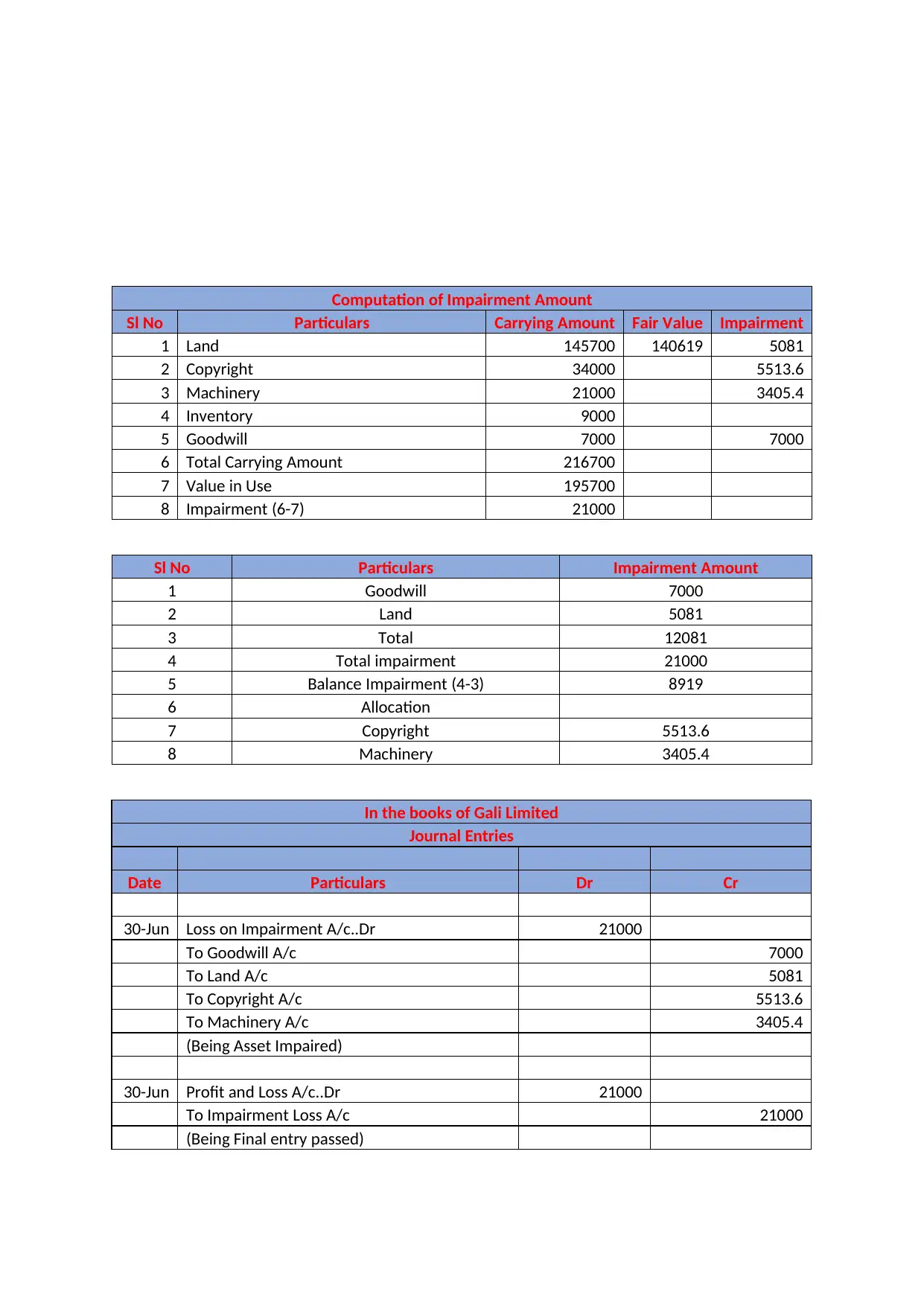
Computation of Impairment Amount
Sl No Particulars Carrying Amount Fair Value Impairment
1 Land 145700 140619 5081
2 Copyright 34000 5513.6
3 Machinery 21000 3405.4
4 Inventory 9000
5 Goodwill 7000 7000
6 Total Carrying Amount 216700
7 Value in Use 195700
8 Impairment (6-7) 21000
Sl No Particulars Impairment Amount
1 Goodwill 7000
2 Land 5081
3 Total 12081
4 Total impairment 21000
5 Balance Impairment (4-3) 8919
6 Allocation
7 Copyright 5513.6
8 Machinery 3405.4
In the books of Gali Limited
Journal Entries
Date Particulars Dr Cr
30-Jun Loss on Impairment A/c..Dr 21000
To Goodwill A/c 7000
To Land A/c 5081
To Copyright A/c 5513.6
To Machinery A/c 3405.4
(Being Asset Impaired)
30-Jun Profit and Loss A/c..Dr 21000
To Impairment Loss A/c 21000
(Being Final entry passed)
Sl No Particulars Carrying Amount Fair Value Impairment
1 Land 145700 140619 5081
2 Copyright 34000 5513.6
3 Machinery 21000 3405.4
4 Inventory 9000
5 Goodwill 7000 7000
6 Total Carrying Amount 216700
7 Value in Use 195700
8 Impairment (6-7) 21000
Sl No Particulars Impairment Amount
1 Goodwill 7000
2 Land 5081
3 Total 12081
4 Total impairment 21000
5 Balance Impairment (4-3) 8919
6 Allocation
7 Copyright 5513.6
8 Machinery 3405.4
In the books of Gali Limited
Journal Entries
Date Particulars Dr Cr
30-Jun Loss on Impairment A/c..Dr 21000
To Goodwill A/c 7000
To Land A/c 5081
To Copyright A/c 5513.6
To Machinery A/c 3405.4
(Being Asset Impaired)
30-Jun Profit and Loss A/c..Dr 21000
To Impairment Loss A/c 21000
(Being Final entry passed)
Paraphrase This Document
Need a fresh take? Get an instant paraphrase of this document with our AI Paraphraser
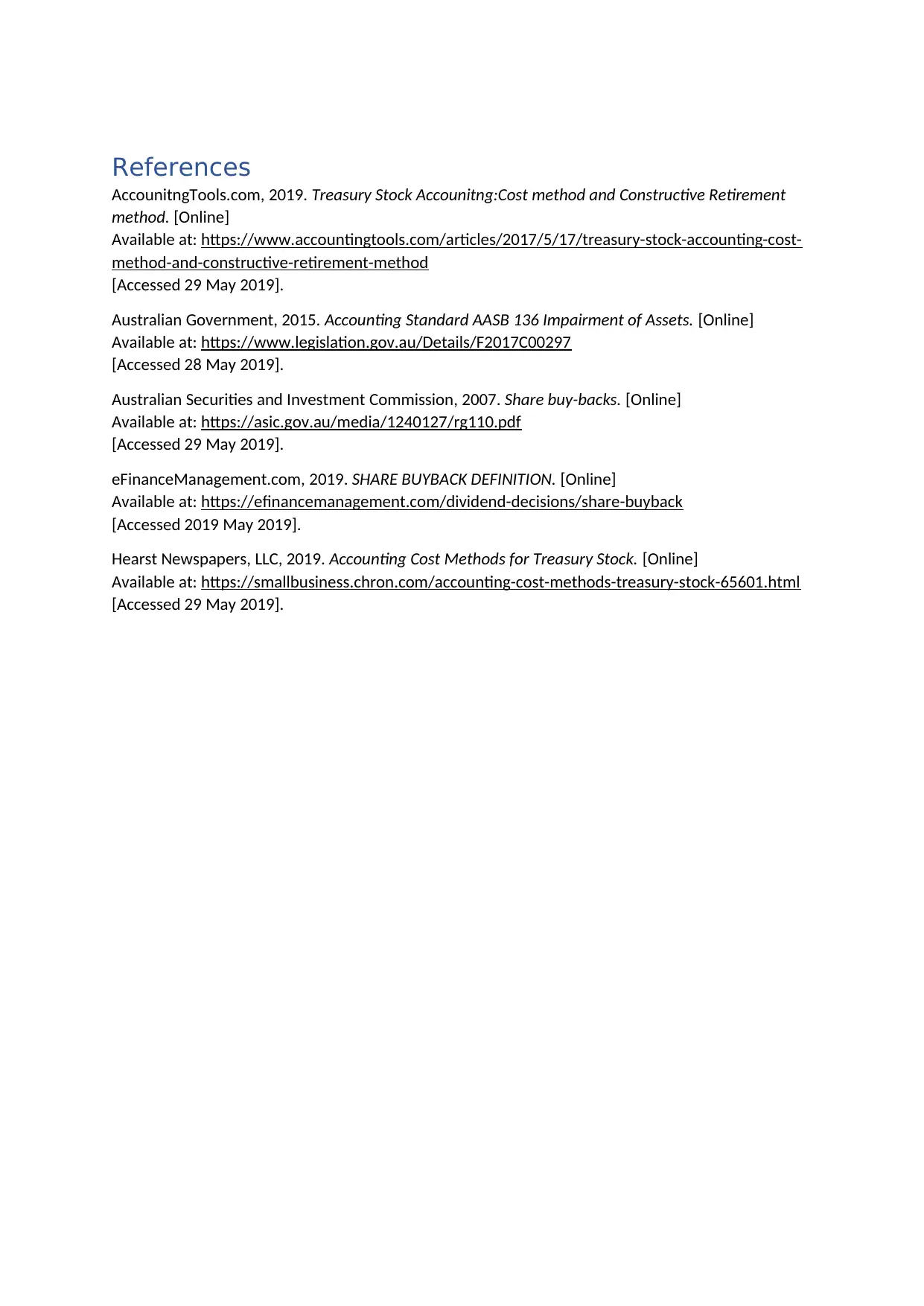
References
AccounitngTools.com, 2019. Treasury Stock Accounitng:Cost method and Constructive Retirement
method. [Online]
Available at: https://www.accountingtools.com/articles/2017/5/17/treasury-stock-accounting-cost-
method-and-constructive-retirement-method
[Accessed 29 May 2019].
Australian Government, 2015. Accounting Standard AASB 136 Impairment of Assets. [Online]
Available at: https://www.legislation.gov.au/Details/F2017C00297
[Accessed 28 May 2019].
Australian Securities and Investment Commission, 2007. Share buy-backs. [Online]
Available at: https://asic.gov.au/media/1240127/rg110.pdf
[Accessed 29 May 2019].
eFinanceManagement.com, 2019. SHARE BUYBACK DEFINITION. [Online]
Available at: https://efinancemanagement.com/dividend-decisions/share-buyback
[Accessed 2019 May 2019].
Hearst Newspapers, LLC, 2019. Accounting Cost Methods for Treasury Stock. [Online]
Available at: https://smallbusiness.chron.com/accounting-cost-methods-treasury-stock-65601.html
[Accessed 29 May 2019].
AccounitngTools.com, 2019. Treasury Stock Accounitng:Cost method and Constructive Retirement
method. [Online]
Available at: https://www.accountingtools.com/articles/2017/5/17/treasury-stock-accounting-cost-
method-and-constructive-retirement-method
[Accessed 29 May 2019].
Australian Government, 2015. Accounting Standard AASB 136 Impairment of Assets. [Online]
Available at: https://www.legislation.gov.au/Details/F2017C00297
[Accessed 28 May 2019].
Australian Securities and Investment Commission, 2007. Share buy-backs. [Online]
Available at: https://asic.gov.au/media/1240127/rg110.pdf
[Accessed 29 May 2019].
eFinanceManagement.com, 2019. SHARE BUYBACK DEFINITION. [Online]
Available at: https://efinancemanagement.com/dividend-decisions/share-buyback
[Accessed 2019 May 2019].
Hearst Newspapers, LLC, 2019. Accounting Cost Methods for Treasury Stock. [Online]
Available at: https://smallbusiness.chron.com/accounting-cost-methods-treasury-stock-65601.html
[Accessed 29 May 2019].
1 out of 5
Related Documents
Your All-in-One AI-Powered Toolkit for Academic Success.
+13062052269
info@desklib.com
Available 24*7 on WhatsApp / Email
![[object Object]](/_next/static/media/star-bottom.7253800d.svg)
Unlock your academic potential
Copyright © 2020–2025 A2Z Services. All Rights Reserved. Developed and managed by ZUCOL.





